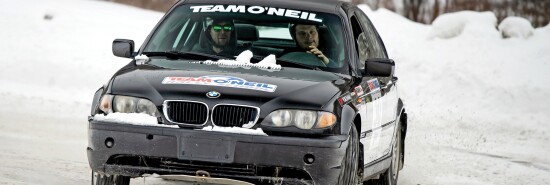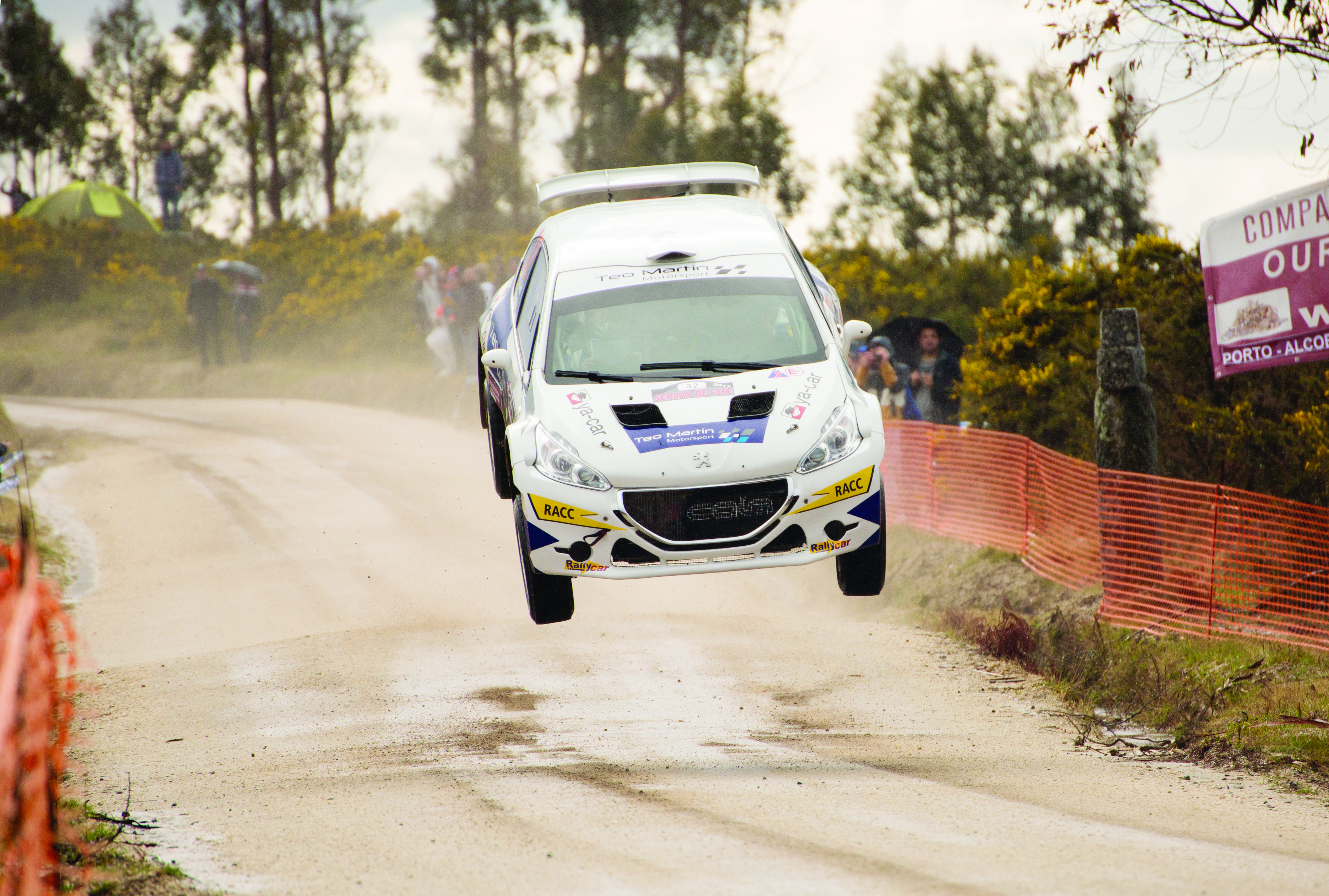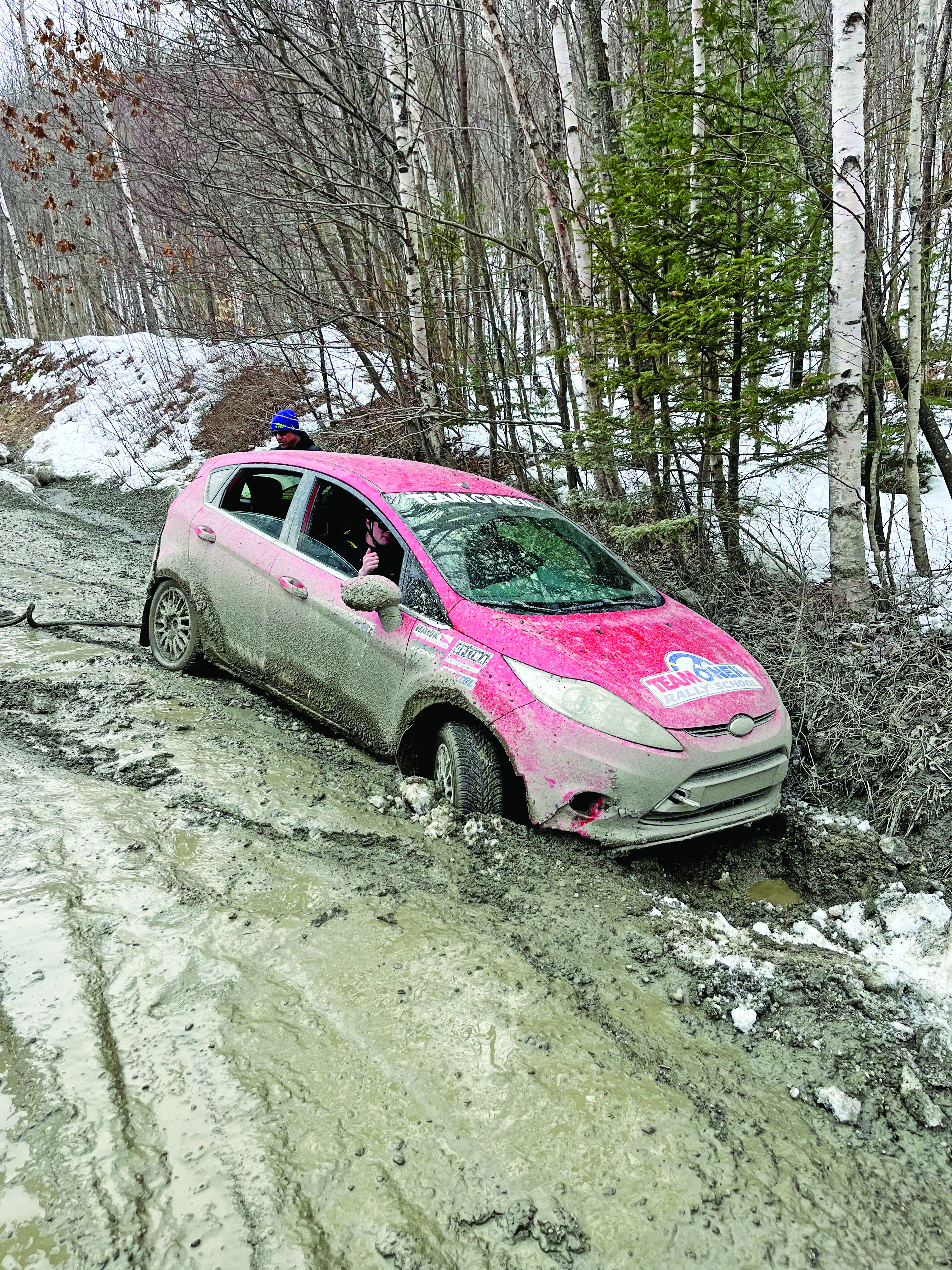
Fury Road
Nicholas Clairmont
W.C. Fields once called Charlie Chaplin “the best ballet dancer that ever lived” for the footwork the Vaudeville star employed in his physical comedy acts. Fields had never seen my pro rally driver instructor in New Hampshire’s White Mountains feather the throttle of a car with one part of his foot while slowly applying the brakes with another part of the same foot, all while using the clutch with the other foot to downshift into a sliding turn that will make a 3,000-pound car dance around an icy slalom course.
On a freezing week at the end of winter, I’ve come to the rally school called Team O’Neil, a sort of mountaintop temple that takes anyone from professional drivers to total novices and teaches them how to race cars fast, precisely, and sideways on all kinds of slippery surfaces along more than six miles of track.

Among the dozen of us who will be driving a fleet of Ford Fiestas, Subaru Imprezas, and BMW 3 Serieses outfitted with roll bars is a woman who flew from India to bone up on her skills before running a pro rally season back home, a group from a Boston-area members-only racetrack for skilled amateur track drivers, and one woman who just learned how to drive a stick shift last night. We don ski helmets and head onto something called a “skidpad,” which is a giant muddy circle of track where we learn to slide. The surface is so slick that, we’re told, “we don’t call it a steering wheel — we call it a suggestion wheel.” Once you turn the tires a little and the rear end comes free from the road, how far the rear of the car pivots is down to the brakes and the gas, so you drive mainly with your feet.
The last piece of advice they give us before we begin? “Use your side windows, they’re facing forward.”
Rally driving is a type of motor sport that started in 1911 in France involving timed runs. But proper rally racing is basically any racing that takes place on roads made of anything except pavement. The World Rally Championship started in the 1977-78 season, and it quickly became one of the most difficult and captivating sports behind an engine, most famously with the “Group B” rally cars of the 1980s. Because it takes place off the road, rallying is much freer and much harder than driving a race car on pavement, something I’ve done before at an amateur level. So my mission at the premier driving school for rally driving training in North America, which hosted me at the school’s own expense, is to try to become the best driver I can be over four days of intensive training.
That training takes place in a classroom set above a large garage where, on some days, the Team O’Neil mechanics wash more than a hundred pounds of mud out of the bottom of each of the cars we’re going to be driving, and in a fleet of modified cars that gives students experience with front-, rear-, and all-wheel drive. Over a short initial seminar session, one of the instructors explains what we’re about to do. First thing, we learn THE RULES:
Stay on the road Don’t break the car Know your equipment Know the limits — yours, the vehicle’s, and the road’s Know your instincts Drive without emotion
Really, an instructor jokes, it’s the first two that count.
The course at Team O’Neil can be set up in almost infinite variations, and the weather changes constantly, meaning the track itself is different every time you drive it. So are you, hopefully: It’s striking how quickly you can gain skill if you pay attention and are willing to take some judicious risks. The main part of the course we learn on is on a hill, with rocky ditches on both sides. As the temperature changes and more cars run the track, the surface goes from white powder snow to black pack ice to slush. After some time learning basics on the skidpad, we’re thrown right into it.
This week, I have to suppress some of my own instincts and trust chief instructor Brent Trail, who is a goofball but a far greater immediate authority on the laws of momentum than I am. Every time it feels like we’re about to drive off the road, Brent smirks under his grey-brown mop and yells “feed ‘er some corn!” instead of “press the accelerator.” But we’re in a place custom designed for high-level screwing around, after all. And I’m keeping the car out of the tree line. Mostly.

We get to an accident avoidance drill, maybe the most important thing we’ll learn the whole time we’re here. When your brakes lock up, the tires are sliding on the road. Locked, sliding wheels have no grip, and turning requires grip. So, if you’re jammed on the brakes trying to slow your car before hitting something, you actually have to stop slowing down — that is, come off the brakes and maybe even accelerate — to get around it. That’s because stepping off the brake pedal will enable the tires to get some “gription,” as they call it here, on the road, and that allows you to regain a bit of control over the car’s direction. Even if you think you understand, intellectually, that this is the right move, your instincts may disagree. After all, this is a unique driving experience for you, so it’s not programmed into your muscle memory. The advantage of having to do this again and again is that it becomes more instinctive with every repetition.
As you’re asked to learn more, it becomes mind-bogglingly complex. As we get into faster and faster cars and start being let loose on bigger sections of track, more skills are necessary, in longer chains, to stay on the road at all — much less to stay going fast. Nobody wants to embarrass themselves by spinning off track, though everyone is supportive when, inevitably, each one of us does.
By the end of Day One, it’s time to start the slalom. That means big, wide, sliding turns right and left. And do you know how you make a front-wheel drive car enter a controlled slide? You hold down the accelerator all the way with your right foot, and when it comes time to slow for the turn you…keep it there. With the throttle pegged, you take your left foot and press the brake at the same time to stop the rear wheels. It feels weird, and then you get it. And then you see yourself drifting around a turn, throwing a plume of mud and ice behind you for the first time, and it feels amazing.
After each day, back out on the road, regular old driving with a seat belt instead of a five-point harness feels mundane and slow, until you remember that it’s the same physics and the lessons all apply. Don’t be surprised if you leave Team O’Neil and find yourself turning down the radio, putting both hands on the wheel, and keeping your eyes up to pay special attention to the road surface, humbled by the complexity and danger of what you’re actually doing, which you now understand in a way you never did before.
“Yer lookin’ at s**t you don’t wanna hit!” Brent yells to me at one point as we crest a hill in a Subaru going about 65 on ice, with temperatures in the single digits on Day Three. If you look at the things you’re trying to avoid driving into, the things you therefore desperately want to look at, your hands and feet will just naturally steer right into them. It’s a phenomenon race car drivers call “target fixation” — and it’s the reason that if you look at a car that’s hit a tree or a lamppost, you’ll notice it probably hit it dead center, as if the driver wasn’t even trying to swerve out of the way. So for performance driving, you always have to look where you want to go, never where you’re worried you might go. You have to cultivate what at Team O’Neil they call “optimistic eyes.” Lesson one: To drive fast, you must first master your own mind. A lot of this is about attitude.
Speaking of attitude: The staff members at Team O’Neil might be the last psychologically healthy people in America, on top of possessing an intuitive understanding of Newtonian mechanics to rival the Massachusetts Institute of Technology’s top physicists. The instructors here have a ton of fun, and they operate like an especially emotionally mature fraternity. They’ve developed a down-home language with one another for this otherwise high-stakes activity. If a car gets stuck into a pile of snow at speed, it “lawndarted.” If you should be gentler on the brake or throttle pedal, you’ll be told to “tickle it.” If you’re not keeping your eyes where they need to be, “keep your head out of your tailpipe!” Some of the instructors come from the world of professional rally, but some aren’t even car guys. There are ski bums who were working chairlifts before they got this gig.
“I don’t know if you’ve noticed, but we’re not the most politically correct here. Any day I don’t get canceled is a good day,” one tells me. (You’re safe, my friend! Not that kind of journalist.) The offensive jokes are of the warmhearted kind, never mean-spirited, mainly because there’s a lot of trust. This is dangerous work. Several instructors told me about getting rolled over or driven into something by students who had yet to learn their limits. When someone new is set to join Team O’Neil, everyone on staff gets a veto. That’s why the social cohesion here is so strong and the mood so high. It makes being here a good time, and it also makes it a good environment to learn to do something that is, essentially, insane.
When the conditions get muddy and icy, the speeds are lower than you’d think could possibly be fun or challenging, often under 40 mph. But you try redirecting thousands of pounds of momentum going 40 with just the grip a few square inches of rubber has against slick ice. It’s both as hard and as joyous as anything you can do in a car. There’s always an instructor in each car, and for each new drill or section, he or she demonstrates it for you first. There are a ton of named maneuvers that go into this dance, from the “Scandinavian flick” to “trail braking” to a handbrake turn. Over the course of one workweek, I don’t get as good at any of it as the instructors are, but the objective is to learn to be passable. And over the course of that workweek, with just one trip into a ditch, I do.
I also learn something else up here on the mountain, with no cell service, with these guys and in these cars, with freezing air, mountain views, and the persistent vroom of engines revving and tires sliding around the next apex and onto the next straightaway. As a college student, I had a chance to spend years studying philosophy. As an amateur race car driver and classic car salesman, I’ve driven Corvettes and vintage 1960s race cars and even formula cars on grippy paved racetracks, trying to wring out the most I can at over a hundred miles an hour. I thought I’d tried to learn something about wisdom and something about driving. Wrong. Zen can be achieved, it turns out, sideways and laughing at 36 miles an hour on a dirt road.
Nicholas Clairmont is the Life & Arts editor of the Washington Examiner magazine.
